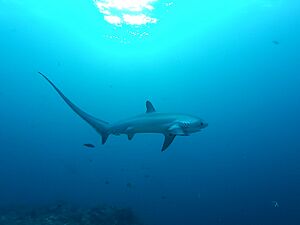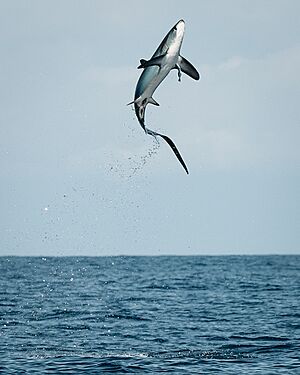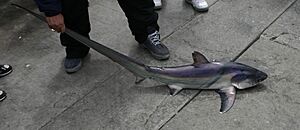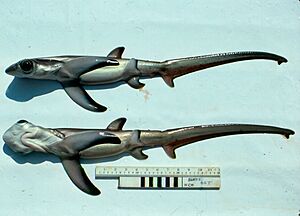Thresher shark facts for kids
Quick facts for kids Thresher shark |
|
|---|---|
 |
|
| Pelagic thresher (A. pelagicus) | |
| Scientific classification |
|
| Kingdom: | Animalia |
| Phylum: | Chordata |
| Class: | Chondrichthyes |
| Order: | Lamniformes |
| Family: | Alopiidae Bonaparte, 1838 |
| Genus: | Alopias Rafinesque, 1810 |
| Type species | |
| Squalus vulpinus Bonnaterre, 1788
|
|
| Synonyms | |
|
|
Thresher sharks are amazing ocean creatures known for their incredibly long, whip-like tails! These large sharks live in warm and mild oceans all around the world. There are three main types of thresher sharks, and they all belong to the Alopias family.
These sharks are active hunters, but they are not considered dangerous to humans. Sadly, all three types of thresher sharks have been listed as "vulnerable" since 2007 by the World Conservation Union (IUCN). This means their populations are decreasing, and they need our help to survive. People fish for them for their meat, oil from their livers, skin, and fins (used in some dishes). They are also popular in sport fishing.
Contents
Amazing Thresher Sharks
The name "Alopias" comes from an ancient Greek word meaning "fox." This is why the common thresher shark is sometimes called the "fox shark." Their common name, "thresher shark," comes from their unique tail, which looks like a farmer's tool called a scythe. This tail can be as long as the shark's body!
Types of Thresher Sharks
There are three main types of thresher sharks alive today:
- Alopias pelagicus (Pelagic thresher)
- Alopias superciliosus (Bigeye thresher)
- Alopias vulpinus (Common thresher)
Scientists are always learning new things! In 1995, some research suggested there might be a fourth, unrecognized species of thresher shark living near Baja California in the eastern Pacific Ocean. We still need to learn more about this possible new shark!
How Scientists Group Thresher Sharks
Scientists use different clues, like genes and teeth, to understand how animals are related. Research shows that thresher sharks are closely related to other large sharks like basking sharks and mackerel sharks. They are all part of a big family tree of ocean predators!
Where Do Thresher Sharks Live?
Thresher sharks mostly live in the open ocean, far from shore. They usually prefer waters that are about 550 meters (1,800 feet) deep or less. However, common thresher sharks can sometimes be found closer to shore, over the edges of continents.
You can find common thresher sharks along the continental shelves of North America and Asia in the North Pacific. In the warmer parts of the Central and Western Pacific, you're more likely to see bigeye and pelagic thresher sharks. Interestingly, one thresher shark was seen much deeper than expected, at the site of an oil spill in the Gulf of Mexico, showing they can adapt to different depths. Bigeye threshers have also been found in the western Mediterranean Sea, suggesting they might live in more places than we thought!
What Makes Them Special?
Thresher sharks are easy to spot because of their incredibly long, scythe-shaped tails. This tail can be as long as the rest of their body! They use this amazing tail to stun their prey.
They have a short head and a cone-shaped nose. Their mouths are usually small, with teeth that vary in size. The biggest of the three species is the common thresher, which can grow up to 6.1 meters (20 feet) long and weigh over 500 kilograms (1,100 pounds)! The bigeye thresher is next, reaching about 4.9 meters (16 feet). The smallest is the pelagic thresher, which is about 3 meters (10 feet) long.
Thresher sharks are quite slender. They have small back fins and large, curved front fins. Except for the bigeye thresher, these sharks have relatively small eyes located towards the front of their heads. Their colors can be brownish, bluish, or purplish-gray on top, and lighter underneath.
You can often tell the three species apart by their main color:
- Common threshers are usually dark green.
- Bigeye threshers are typically brown.
- Pelagic threshers are generally blue.
Remember, how a shark looks can change with light and water clarity, but these colors are a good general guide!
What Do Thresher Sharks Eat?
Thresher sharks are skilled hunters! They mainly eat fish that swim in schools, like bluefish, young tuna, and mackerel. They sometimes follow these fish into shallower waters. They also enjoy squid and cuttlefish. Occasionally, they might even eat crustaceans (like crabs) or seabirds!
Their long tail is their secret weapon. They use it like a whip to stun their prey before eating it.
How Do Thresher Sharks Behave?
Thresher sharks are mostly solitary, meaning they prefer to be alone. However, some species have been seen hunting in small groups of two or three. They are known for traveling long distances across the ocean.
When hunting schooling fish, thresher sharks are famous for "whipping" the water with their long tails. This action stuns the smaller fish, making them easier to catch. Thresher sharks are also one of the few shark species that can jump completely out of the water! This amazing behavior, called "breaching," happens when they use their powerful tails to launch themselves into the air, sometimes even turning like dolphins.
Staying Warm in the Ocean
Some thresher sharks have a special way to stay warm in the ocean! They have a unique system of blood vessels and red muscle that acts like a natural heater. This system helps them keep their body temperature warmer than the surrounding water. This is similar to how some other sharks, like mackerel sharks, stay warm, allowing them to be active hunters in cooler waters.
The Thresher Shark Life Cycle
Thresher sharks don't have a specific breeding season. The baby sharks grow inside the mother. This is called ovoviviparous reproduction, which means they give birth to live young. They usually have a small litter, typically two to four pups. These pups are quite large and well-developed when they are born, sometimes up to 150 centimeters (59 inches) long for common threshers!
While inside the mother, the young sharks use up their yolk sacs. After that, they start eating the mother's unfertilized eggs for nourishment. This process is called oophagy.
Thresher sharks grow up slowly. Males become ready to have babies between seven and thirteen years old, and females between eight and fourteen years old for bigeye threshers. They can live for 20 years or even longer!
In October 2013, a special moment was captured off the coast of the Philippines: the first picture ever taken of a thresher shark giving birth!
Why Are Thresher Sharks Important?
Thresher sharks are popular for sport fishing in places like the United States and South Africa. Common thresher sharks are especially sought after by recreational fishers off Baja, Mexico.
Protecting Thresher Sharks
Because thresher sharks have only a few babies at a time and grow slowly, they are very sensitive to being overfished. This means that if too many are caught, their populations can quickly shrink. As mentioned earlier, all three species have been listed as "vulnerable to extinction" by the World Conservation Union (IUCN) since 2007. It's important to protect these incredible sharks so they can continue to thrive in our oceans!
See also
- Shark meat




